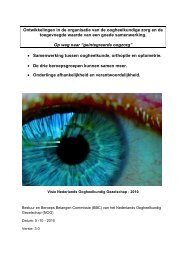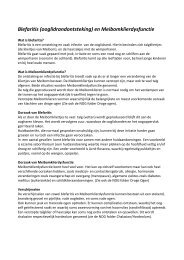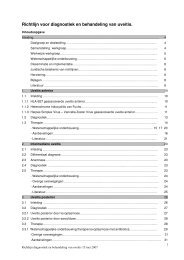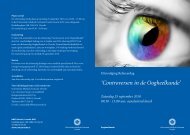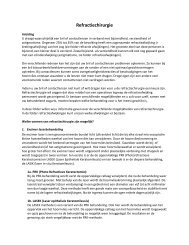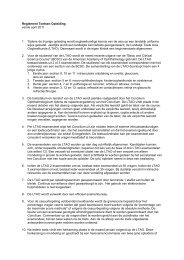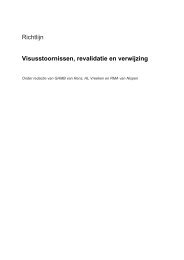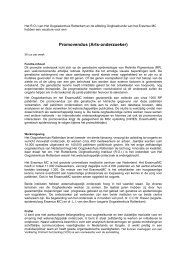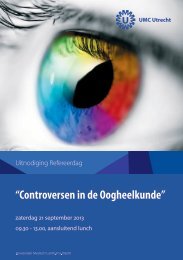terminology and guidelines for glaucoma ii - Kwaliteitskoepel
terminology and guidelines for glaucoma ii - Kwaliteitskoepel
terminology and guidelines for glaucoma ii - Kwaliteitskoepel
You also want an ePaper? Increase the reach of your titles
YUMPU automatically turns print PDFs into web optimized ePapers that Google loves.
T<br />
A<br />
R<br />
G<br />
E<br />
T<br />
I<br />
O<br />
P<br />
Target IOP range<br />
Target pressure<br />
according to<br />
risk<br />
Fig. 3.2.1 - TARGET IOP<br />
Diagrammatic evaluation of<br />
the desired therapeutic outcome<br />
in <strong>for</strong>m of IOP-lowering.<br />
The target pressure<br />
should be situated within the<br />
shaded area. The lower is<br />
the initial IOP, the lower<br />
will be the Target IOP <strong>and</strong><br />
viceversa. The percentage of<br />
IOP reduction targeted (i.e.<br />
20%, 30%, 40% respectively)<br />
depends mainly on the<br />
degree of VF damage at diagnosis<br />
<strong>and</strong> on rate of progression<br />
(RoP).<br />
3.2.2 - THE QUALITY OF LIFE (QoL)<br />
The quality of life (QoL) is hard to quantify as an outcome measure. For patients however it is one of the most<br />
important. Individuals diagnosed with <strong>glaucoma</strong> can lose quality of life <strong>for</strong> several reasons 23-32 , alone or in combination<br />
(see FC I):<br />
a) Diagnosis of <strong>glaucoma</strong>. Being diagnosed as having a chronic <strong>and</strong> potentially blinding disease generates worries<br />
<strong>and</strong> anxiety in patients <strong>and</strong> their families.<br />
b) Functional loss due to the disease<br />
c) Inconvenience of the treatment<br />
d) Side effects of the treatment<br />
e) Cost of the treatment<br />
Each person should be approached by asking their own perceptions on their present status <strong>and</strong> on their course as<br />
well as asked to describe their difficulties with daily tasks (see FC I).<br />
When the disease is not likely to interfere with the QoL, not initiating or witholding treatment is an option to be<br />
discussed with the patient.<br />
In order to help our patients to maintain a “healthy” status, we need to focus not only on the treatment of the disease<br />
process, but also on the effect of both our diagnosis <strong>and</strong> treatment on the individual.<br />
Age-Related ganglion cells loss will continue: to reach target IOP is intended to prevent only <strong>glaucoma</strong>-related functional<br />
loss.<br />
REMEMBER:<br />
* Assess each eye individually when deciding the most appropriate therapy.<br />
* It is essential to involve patients as in<strong>for</strong>med partners in decisions regarding the management of<br />
their condition.<br />
* The least amount of medication (<strong>and</strong> consequent inconvenience, costs <strong>and</strong> side effects) to achieve<br />
the therapeutic response should be a consistent goal.<br />
* A therapeutic medical trial on one eye first is useful, although not always logistically feasible.<br />
* Usually there is no need to start treatment until all baseline diagnostic data are collected.<br />
* A single IOP measurement, unless grossly abnormal, is an insufficient parameter upon which solely base the<br />
diagnosis <strong>and</strong> future patient management.<br />
Ch. 3 - 6 EGS



